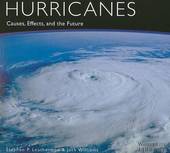
|
Hurricanes: Causes, Effects, and the Future
Paperback / softback
Main Details
| Title |
Hurricanes: Causes, Effects, and the Future
|
| Authors and Contributors |
By (author) Stephen P. Leatherman
|
|
By (author) Jack Williams
|
| Physical Properties |
| Format:Paperback / softback | | Pages:72 |
|
| Category/Genre | World history
Meteorology and climatology
Natural disasters |
|---|
| ISBN/Barcode |
9780760329924
|
| Classifications | Dewey:551.552 |
|---|
| Audience | |
|---|
|
Publishing Details |
| Publisher |
Motorbooks International
|
| Imprint |
Motorbooks International
|
| Publication Date |
10 September 2008 |
| Publication Country |
United States
|
Description
For many Americans, Katrinas deadly destructiveness offered a first harrowing lesson in the power of hurricanes. For those living along the Atlantic Coast and the Gulf of Mexico, Katrina was one more disastrous encounter with an overwhelming force of nature. As evidence mounts that these tropical cyclones will only grow more frequent and intense, this book offers a much-needed opportunity to understand the workings of hurricanes. Two recognized authorities on climate and weather gives readers a close look at hurricanes past and present, from the historic Galveston storm of 1900 to the devastating Katrina. Along with near-incredible stories of damage wreaked and lives altered, this book provides a clear and concise introduction to the mechanics of the storms. In scientifically accurate but easily comprehensible terms, the authors explain the formidable wind speed, the heavy rains, and the eye of the hurricane, all accompanied by detailed diagrams and spectacular color photographs. Their work makes it possible for readers to make informed decisions about a natural phenomenon that increasingly affects our lives.
Author Biography
Jack Williams is a science journalist who specializes in weather and climate. He edited the USA Today weather page for more than fifty years and is the author of The Complete Idiotu2019s Guide to the Arctic and Antarctic, Hurricane Watch, The Weather Almanac, and The Weather Book. Williams and his wife live in Falls Church, Virginia.Stephen P. Leatherman, known nationwide as Dr. Beach, is an authority on coastal geography and beach management. He is the author of Dr. Beach's Survival Guide and the editor of Sea Level Rise, among others, and the director of the International Hurricane Research Center & Laboratory for Coastal Research. Leatherman and his wife live in Miami, Florida. Jack Williams is a science journalist who specializes in weather and climate. He edited the USA Today weather page for more than fifty years and is the author of The Complete Idiot's Guide to the Arctic and Antarctic, Hurricane Watch, The Weather Almanac, and The Weather Book. Williams and his wife live in Falls Church, Virginia.
ReviewsForeWord This Week by Whitney Hallberg, Managing Editor "Hurricanes" by Jack Williams and Stephen Leatherman (978-0-7603-2992-4) explores "Earth's fiercest storms" with fifty color photos and descriptions of hurricane behavior. Winds must reach 74 miles per hour in order for a storm to be considered a hurricane, but they regularly reach speeds greater than 100 miles per hour and create 50-foot waves. The book looks at U.S Air Force Reserve pilots who fly into hurricanes to provide wind data to forecasters. "On a typical nine- or ten-hour flight, an airplane will make maybe a half dozen trips all of the way across a storm, following a different path each time," the authors write. "Each trip goes through the turbulent eye-wall and the calm eye." Williams and Leatherman explain that a hurricane's winds "could affect more than 200 miles of coastline," and that the names of the storms come from a National Hurricane Center-approved list of men's and women's names in French, English, and Spanish that is created each year. The photographs are especially fascinating, including one taken from the eye of Katrina before she hit, and several taken from space. A satellite image of Fran, which hit North Carolina, shows the winds that affected the weather in New England and the Midwest, even causing flooding in Ohio. ForeWord This Week by Whitney Hallberg, Managing Editor Hurricanes by Jack Williams and Stephen Leatherman (978-0-7603-2992-4) explores "Earth's fiercest storms" with fifty color photos and descriptions of hurricane behavior. Winds must reach 74 miles per hour in order for a storm to be considered a hurricane, but they regularly reach speeds greater than 100 miles per hour and create 50-foot waves. The book looks at U.S Air Force Reserve pilots who fly into hurricanes to provide wind data to forecasters. "On a typical nine- or ten-hour flight, an airplane will make maybe a half dozen trips all of the way across a storm, following a different path each time," the authors write. "Each trip goes through the turbulent eye-wall and the calm eye." Williams and Leatherman explain that a hurricane's winds "could affect more than 200 miles of coastline," and that the names of the storms come from a National Hurricane Center-approved list of men's and women's names in French, English, and Spanish that is created each year. The photographs are especially fascinating, including one taken from the eye of Katrina before she hit, and several taken from space. A satellite image of Fran, which hit North Carolina, shows the winds that affected the weather in New England and the Midwest, even causing flooding in Ohio.
|